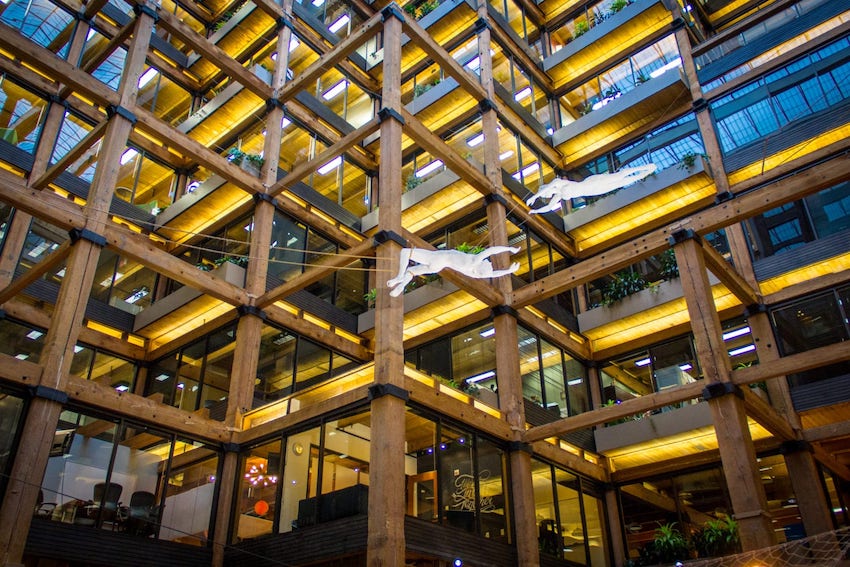Adapt and Reuse: Innovating with New Timber Technologies
Presented by Susan Jones AIA, Timothy Wolosz AIA, Angela Samargia, LEED AP, CPM, RPA
Learning Objectives:
- Explain how adaptive reuse reduces a building’s embodied carbon and preserves authentic qualities of the built environment that provide a tangible link with the past.
- Describe several adaptations to historic post-and-beam structures to meet contemporary green building standards.
- Discuss how mass timber technologies can create an efficient transition from existing buildings to new construction by reducing project timelines and the volume of material waste sent to landfill.
- Explore the aesthetic and money-saving potential of cross-laminated timber (CLT) construction for adaptive reuse projects.
Credits:
AAA 1 Structured Learning Hour
This course can be self-reported to the AANB, as per their CE Guidelines
AAPEI 1 Structured Learning Hour
MAA 1 Structured Learning Hour
This course can be self-reported to the NLAA.
This course can be self-reported to the NSAA
NWTAA 1 Structured Learning Hour
SAA 1 Hour of Core Learning
This course can be self-reported to the AIBC, as per their CE Guidelines.
As an IACET Accredited Provider, BNP Media offers IACET CEUs for its learning events that comply with the ANSI/IACET Continuing Education and Training Standard.
This course is approved as a Structured Course
This course can be self-reported to the AANB, as per their CE Guidelines
Approved for structured learning
Approved for Core Learning
This course can be self-reported to the NLAA
Course may qualify for Learning Hours with NWTAA
Course eligible for OAA Learning Hours
This course is approved as a core course
This course can be self-reported for Learning Units to the Architectural Institute of British Columbia
This test is no longer available for credit
It has been said that the greenest buildings are the ones that already exist. Adaptive reuse is the process of redeveloping structurally sound existing buildings for economically viable modern uses, infusing new life into a historic shell. Adaptive reuse can also allow a project to significantly reduce its embodied carbon as well as the volume of materials sent to landfill through construction, helping to achieve low-carbon construction goals.
Wood is a material well-suited to reuse, whether through the adaptive reuse of an existing structure or through deconstruction and disassembly. In particular, long-standing heavy timber beams in existing buildings and structures are sought after for their durability and strength, along with their aesthetic beauty and historic significance. In this course, we will examine several adaptive reuse case studies that feature wood construction, both heavy timber beams and more modern mass timber products.
In this webinar, three projects will be presented that illustrate these principles. Butler Square in Minneapolis, Minnesota, is a nine-story historic tall timber building constructed as a warehouse more than 100 year ago. Today, Butler Square continues to operate as a vibrant sought-after mixed-use office building with modern amenities and sustainable design features. Milwaukee’s first mass timber building, Timber Lofts, is an adaptive reuse project that combines a 130-year-old warehouse renovation with new construction in an adjacent parcel. The two structures unite to create a 60-unit multi-family complex. Bellevue First Congregational Church in Bellevue, Washington, demonstrates adaptive reuse for commercial space into a church featuring mass timber new construction.

Photo courtesy of Think Wood

|
Susan Jones, Founder is a national leader in the mass timber community, represented over 90,000 architects on behalf of the American Institute of Architects in 2016 to successfully change American building codes to allow tall mass timber buildings up to 18 stories in the US. The firm's research work also includes working with The Nature Conservancy and the USDA on a series of grants to test life-cycle analyses for Mass Timber, as well as directing fire testing of Mass Timber in the US and internationally. In 2018, she published a book, Mass Timber | Design and Research, which was launched in New York City, London, Tokyo and Seattle.
Susan earned her B.A from Stanford in Philosophy, and her M.Arch from the Harvard GSD. She is licensed in multiple states, has been a visiting design critic at numerous universities, and is Affiliate Associate Professor of Architecture at the University of Washington. She was made a Fellow of the American Institute of Architects in 2010.
|

|
Timothy Wolosz, Principal is a multi-disciplinary designer that specializes in comprehensive project design and delivery. Tim’s award-winning project experience includes the Milwaukee Institute of Art and Design Two50Two, a student residence hall in the Historic Third Ward, and the Huron Building. The project has won numerous awards including AIA Wisconsin Merit Award 2015 and the Milwaukee Business Journal – Best New Development Residential. Other notable projects include The Standard at East Library General Mitchell International Airport – Baggage Claim.
Tim holds a Master of Architecture degree from the University of Miami in Florida. Since his academic experience extends beyond his own education and he has had a variety of teaching opportunities at the University of Wisconsin, Milwaukee, as an Adjunct Professor from 2010 to present.
|

|
Angela Samargia is a Senior Property Manager with McGough Facility Management at the historic Butler Square office building in Minneapolis. She has served on multiple committees with IREM for over 10 years. Angela enjoys connecting with other property managers and vendors in our industry. She says, "It’s great to be able to talk with people who share a same connection, share stories about our properties and share best practices."
IREM membership has provided opportunities for Angela to meet many great people in property management and leadership roles, as well as vendors who can help out in a bind! When Angela needs market data for clients, she has nume
rous managers to take a poll from and ask direct best practice questions too. IREM also keeps everyone up to date with general market conditions and new practices in the industry. IREM has also been a great recruiting tool for finding quality, long term talent.
|
Originally published in December 2021

















